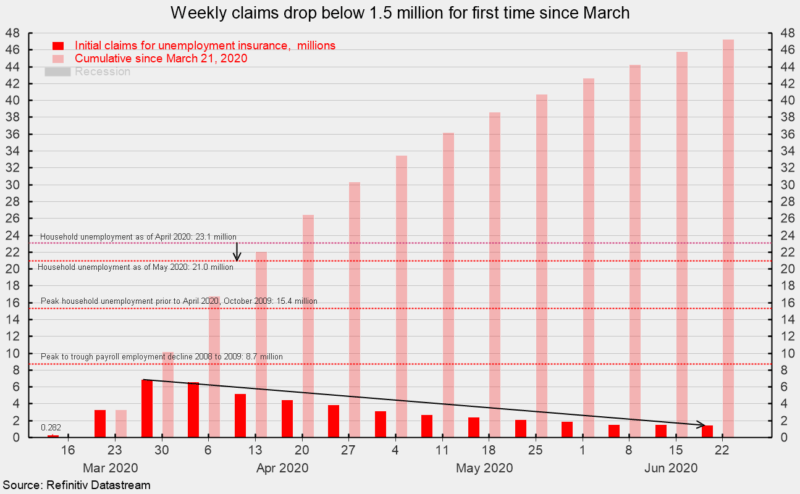Reopening is Helping Drive Initial Unemployment Claims Lower
The devastating impact of government shutdown policies over the last 14 weeks is showing signs of ease as the economy moves ahead with reopening. The policy-induced recession is already setting records in terms of severity and more bad news is likely still to come. However, there are some early signs that the path towards reopening is helping establish a bottom in some areas of the economy, setting the stage for growth.
Initial claims for unemployment insurance totaled 1.48 million for the week ending June 20, marking the fourteenth consecutive week of historically massive layoffs following the implementation of business and consumer lockdowns intended to fight the COVID-19 pandemic (see chart). However, claims have slowed for the twelfth straight week after registering 6.87 million for the week ending March 28 and have fallen below 1.5 million for the first time since March 14.
The current 14-week total of 47.25 million initial claims is 5.4 times the total of the 8.7 million job losses that occurred over 25 months versus during the Great Recession (see chart). The current total is also 3 times the 15.4 million peak number of unemployed people for the Great Recession, as measured in the household survey portion of the monthly Employment Situation report (see chart).
The national Employment Situation report for May was released on Friday, June 5 and showed a gain of 2.5 million in nonfarm jobs following a 20.7 million loss in April, as reported in the establishment survey portion of the report. Total unemployed in May was 21.0 million, down from 23.1 million in April (see chart), as reported in the household survey portion of the report.
The unemployment rate fell to 13.3 percent (though the Bureau of Labor Statistics noted that improper responses likely underreported the rate and is likely about 3 points higher, near 16 percent) versus 14.7 percent in April (and nearly 20 percent if corrections were made to the April number). The previous cycle peak in the unemployment rate was 10 percent in October 2009 while the highest unemployment rate since 1950 came in November 1982 at 10.7 percent. Though data collection was much less reliable, the unemployment rate following the Great Depression was estimated to have peaked at about 25 percent in 1933.
The next Employment Situation report covering the month of June is due out on Thursday, July 2 and current consensus is for a gain of 3 million payroll jobs.






